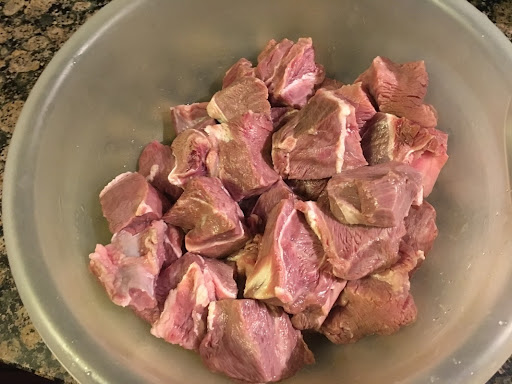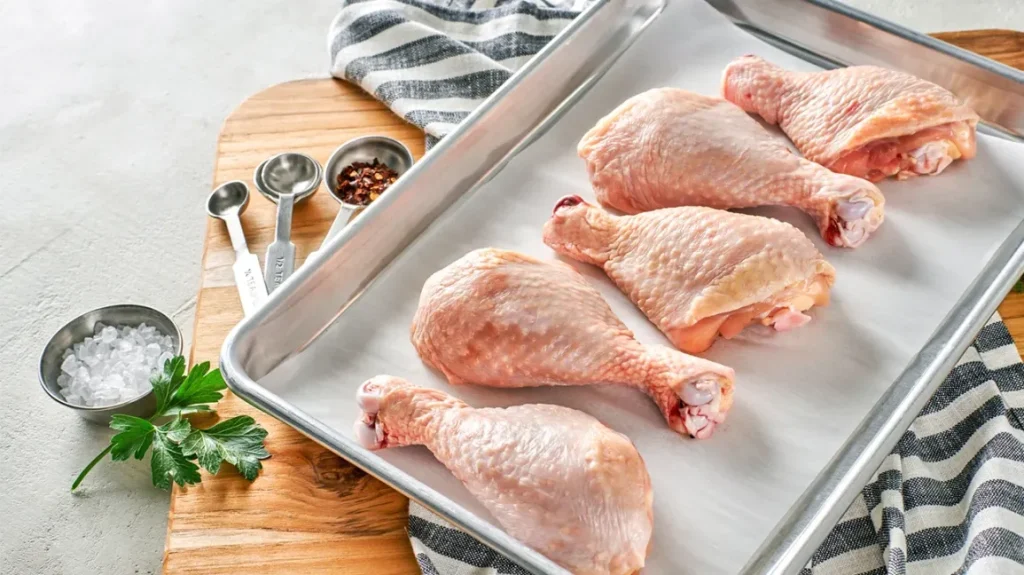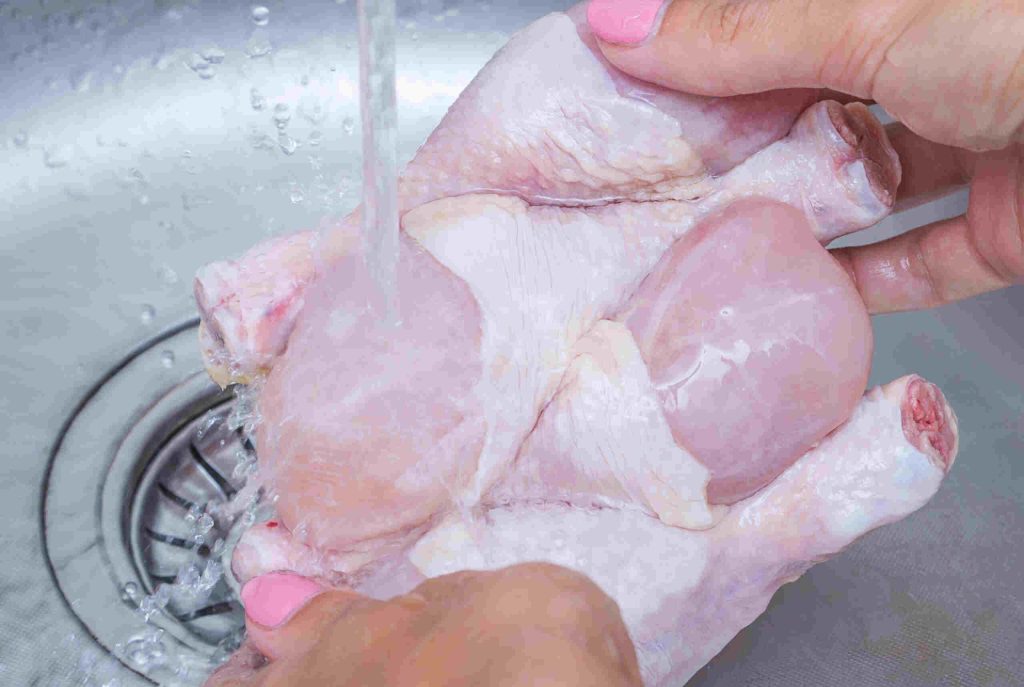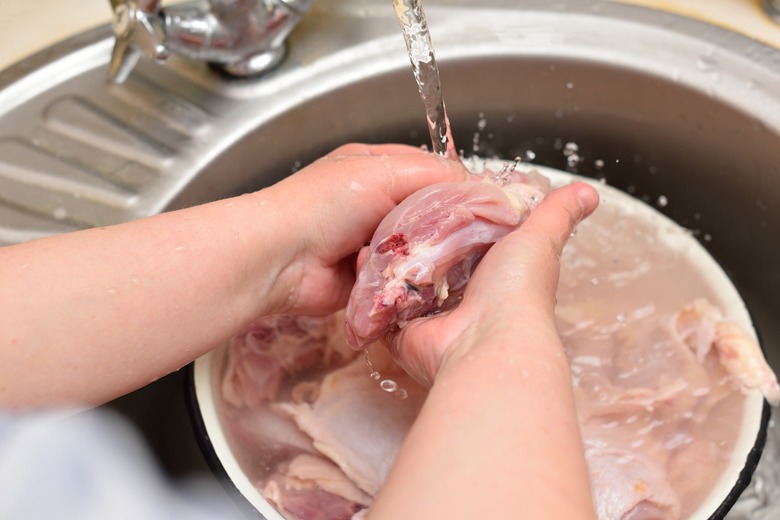Introduction:
Should You Wash Meat Before Cooking When preparing meat, one of the most common questions that home cooks face is whether they should wash it before cooking. This seemingly simple task has sparked debate among culinary enthusiasts, food safety experts, and everyday cooks. While many believe that rinsing meat is essential to remove dirt and bacteria, others argue that it could do more harm than good. Let’s delve into this topic to understand whether washing meat is a safe practice or an unnecessary step.
The Historical Perspective
For generations, washing meat before cooking has been a common practice in many households. This ritual stems from the belief that washing can remove blood, dirt, and contaminants from the surface of the meat. In some cultures, washing meat is seen as an essential step in maintaining hygiene and ensuring that the food is clean before it is cooked.
However, the context in which this practice originated is quite different from today’s kitchen environment. In the past, meat might have been less processed, more prone to contamination, or stored under less stringent conditions, making washing a seemingly necessary step. But with modern advancements in food processing and safety regulations, the question arises: Is this practice still relevant?
The Case Against Washing Meat
Contrary to traditional beliefs, most food safety experts and organizations, including the U.S. Department of Agriculture (USDA), advise against washing meat before cooking. The primary reason is that washing raw meat can increase the risk of cross-contamination. When you rinse meat under running water, bacteria from the meat’s surface can splash onto nearby surfaces, utensils, and even other foods, leading to the spread of harmful pathogens like Salmonella and Campylobacter.
Furthermore, washing meat does not effectively remove bacteria. Cooking meat to the proper internal temperature is the only reliable method to kill harmful microorganisms. For example, poultry should be cooked to an internal temperature of 165°F (74°C), while beef, pork, and lamb should reach at least 145°F (63°C) with a three-minute rest time.
The Case for Washing Meat
Despite the widespread advice against washing meat, some people continue to do so, driven by cultural practices, personal habits, or a desire to ensure cleanliness. Some advocates argue that washing can remove slime, blood, and residue, making the meat more palatable before cooking.
In certain cases, such as washing off marinades or brines, it might seem logical to rinse the meat. However, even in these instances, food safety experts recommend patting the meat dry with paper towels instead of rinsing it under water to minimize the risk of contamination.
Alternatives to Washing Meat
If you’re concerned about the cleanliness of your meat, there are safer alternatives to washing it. Here are a few tips:
Pat Dry: Use paper towels to blot the surface of the meat to remove any moisture or residue. Dispose of the paper towels immediately to avoid cross-contamination.
Use a Clean Work Area: Ensure that your kitchen surfaces, utensils, and hands are clean before and after handling raw meat. Regularly sanitize surfaces that come into contact with raw meat.
Proper Cooking: As mentioned earlier, cooking meat to the correct internal temperature is the most effective way to kill harmful bacteria. Invest in a reliable meat thermometer to ensure that your meat is cooked thoroughly.
Marinating Tips: If you marinate meat, do so in the refrigerator rather than at room temperature. After marinating, discard the used marinade and avoid rinsing the meat.

Conclusion
The debate over washing meat before cooking is rooted in tradition and personal preference. However, from a food safety standpoint, the risks of cross-contamination outweigh any perceived benefits. Modern food safety practices prioritize proper cooking and kitchen hygiene over washing meat. So, while it might be difficult to break old habits, embracing these safer alternatives can help you protect yourself and your family from foodborne illnesses.
In the end, whether you choose to wash meat or not is a personal decision, but it’s essential to be informed about the potential risks and best practices for handling and cooking meat safely.
Why do people wash meat before cooking?
Washing meat before cooking is a practice that has persisted in kitchens worldwide for generations. Despite advice from food safety experts against this practice, many people continue to rinse their meat before cooking. But why do people feel compelled to wash meat, and what drives this deeply ingrained habit? To understand this, we need to explore cultural traditions, psychological factors, and historical contexts that have shaped this practice.
Cultural Traditions and Heritage
For many, washing meat is more than just a routine step in food preparation—it is a tradition passed down through generations. In various cultures, washing meat is considered an essential part of ensuring the cleanliness and safety of food. This practice often reflects a broader cultural emphasis on cleanliness, where washing food is seen as a way to purify it before consumption.
In some regions, the environment and local practices historically necessitated more rigorous cleaning of food. For example, in areas where water sources were questionable or where meat was handled in open markets, washing meat became a vital step in removing visible dirt, blood, or potential contaminants. This necessity became deeply embedded in culinary traditions, and even today, people may wash meat out of respect for these long-standing customs.
Perception of Cleanliness and Safety
Another significant factor behind the practice of washing meat is the perception of cleanliness. Many people feel that washing meat removes surface impurities, blood, and slime that might otherwise end up on their plates. This sense of cleanliness is psychological, providing reassurance that the food is safe to eat.
The act of washing meat can also serve as a mental barrier against the fear of foodborne illness. Even though modern food safety standards have reduced the need for such measures, the sight of raw meat can still evoke concerns about bacteria and contamination. Washing the meat gives a sense of control over these fears, even if the act itself doesn’t significantly reduce the risk of contamination.
Historical Context and Changing Food Practices
The origins of washing meat can also be traced back to earlier food practices when meat was processed and stored in less sanitary conditions. Before the advent of refrigeration and modern food preservation techniques, meat was often kept in environments where it could easily become contaminated. Washing it before cooking was a logical precaution to remove any visible dirt or debris.
Over time, even as food safety and preservation methods improved, the habit of washing meat persisted. This practice was passed down through generations, with each new cook adopting the method as part of their standard food preparation routine. While today’s meat processing is much more hygienic, the legacy of these older practices continues to influence modern kitchen habits.
Misinformation and Conflicting Advice
The decision to wash meat is also influenced by the abundance of conflicting advice available on the subject. For years, cookbooks, food blogs, and even some health guides have suggested washing meat as a preparatory step. As a result, many people have internalized this advice, believing it to be a necessary part of cooking.
The spread of misinformation and mixed messages about food safety has only compounded the issue. For example, some believe that washing meat is necessary to remove bacteria, not realizing that rinsing can actually spread bacteria to kitchen surfaces, utensils, and other foods. Without clear, consistent guidance, people often default to the practices they know, which for many, includes washing meat.
Conclusion
Washing meat before cooking is a practice steeped in tradition, driven by a desire for cleanliness, and rooted in historical context. While modern food safety experts advise against it due to the risks of cross-contamination, the practice persists because it is ingrained in cultural habits and reinforced by a perception of safety.
Understanding why people wash meat can help in addressing food safety education more effectively. By recognizing the cultural and psychological factors at play, food safety experts can better communicate the importance of safe handling practices, encouraging a shift away from potentially hazardous habits. While it might be challenging to change a practice so deeply embedded in tradition, awareness and education are key to ensuring that modern kitchens are not only respectful of heritage but also aligned with the best practices for health and safety.
What meats need to be washed before cooking?
Should You Wash Meat Before Cooking The practice of washing meat before cooking has long been a topic of debate among home cooks, chefs, and food safety experts. While many people believe that washing meat is necessary to remove bacteria and contaminants, others argue that it can actually do more harm than good. So, which meats, if any, need to be washed before cooking? To answer this question, it’s important to look at the recommendations from food safety authorities and understand the reasons behind these guidelines.
The General Consensus:
For the majority of meats, including poultry, beef, pork, lamb, and seafood, the consensus among food safety experts is clear: these meats do not need to be washed before cooking. Here’s why:
Cross-Contamination Risk: Washing raw meat under running water can cause water droplets containing bacteria to splash onto surrounding surfaces, utensils, and other foods.
Ineffectiveness of Washing: Washing meat does not effectively remove bacteria. Harmful pathogens like Salmonella, E. coli, and Campylobacter are often present on the surface of raw meat, but they can only be killed by cooking the meat to the proper internal temperature. For example, poultry should be cooked to 165°F (74°C), while beef, pork, and lamb should reach at least 145°F (63°C) with a three-minute rest time.
Modern Meat Processing: In many countries, meat processing facilities are subject to stringent hygiene standards, reducing the likelihood of significant contamination that would require washing. By the time meat reaches your kitchen, it has typically been cleaned and inspected to ensure safety.
Exceptions to the Rule: When Washing Meat Might Be Appropriate
While most meats do not need to be washed, there are a few exceptions where washing could be considered, albeit with caution:
Organ Meats: Some organ meats, such as liver, kidneys, and tripe, might be washed to remove excess blood or to rinse off any unpleasant odors. If you choose to wash these meats, do so carefully to avoid splashing, and clean your sink and surrounding area thoroughly afterward.
Salt-Cured or Dried Meats: In some cases, salt-cured meats like bacon, pancetta, or salted fish might be rinsed to remove excess salt before cooking. However, this should be done gently and with minimal splashing. After rinsing, pat the meat dry with paper towels.
Fresh Fish and Seafood: Some types of fresh seafood, particularly shellfish like clams, mussels, and oysters, may need to be rinsed to remove sand or grit. It’s important to note that rinsing should be done carefully to avoid cross-contamination, and the seafood should be cooked immediately after washing.
Best Practices for Handling Meat Safely
Rather than washing meat, following safe handling and cooking practices is the best way to ensure that your food is safe to eat. Here are some tips:
Cook Meat Thoroughly: As mentioned earlier, cooking meat to the proper internal temperature is the most effective way to kill harmful bacteria. Use a meat thermometer to ensure that your meat has reached a safe temperature.
Avoid Cross-Contamination: Keep raw meat separate from other foods in your kitchen. Use separate cutting boards for meat and vegetables, and wash your hands, utensils, and surfaces thoroughly after handling raw meat.
Pat Dry Instead of Washing: If you feel the need to remove moisture or residue from meat, use paper towels to pat it dry rather than rinsing it under water. This minimizes the risk of spreading bacteria.
Proper Storage: Store meat at the appropriate temperature in the refrigerator or freezer, and avoid leaving it out at room temperature for extended periods.
Conclusion
The notion that meats need to be washed before cooking is a widespread but outdated belief. For most meats, including poultry, beef, pork, lamb, and seafood, washing is unnecessary and can even be counterproductive due to the risk of cross-contamination. The key to safe meat preparation lies in proper cooking, careful handling, and maintaining a clean kitchen environment.
While there are a few exceptions where washing might be appropriate, such as with organ meats or salt-cured products, these should be handled with care and only when necessary. By understanding the reasons behind these guidelines, home cooks can make informed decisions that prioritize both safety and tradition in the kitchen.

Do chefs wash the meat?
In home kitchens around the world, the question of whether to wash meat before cooking is a common topic of debate. But what about in professional kitchens? Do chefs, with their rigorous training and high standards for food safety, wash meat before preparing it? The answer might surprise you, as it reflects both the strict guidelines of food safety practices and the evolving understanding of what’s best in the culinary world.
Food Safety Training and Professional Standards
Chefs in professional kitchens are trained extensively in food safety, often through certification programs like ServSafe in the United States or similar courses elsewhere. These programs emphasize the importance of preventing cross-contamination and handling food in a way that minimizes the risk of foodborne illnesses. As part of this training, chefs learn that washing meat is generally unnecessary and can even be harmful.
The guidelines provided by food safety authorities, such as the U.S. Department of Agriculture (USDA) and the Food Standards Agency (FSA) in the UK, advise against washing raw meat, including poultry, beef, pork, and lamb. These agencies highlight the risk of spreading bacteria through water splashes, which can contaminate kitchen surfaces, utensils, and other foods.
The Practice in Professional Kitchens
In line with these guidelines, most chefs do not wash meat before cooking. Instead, they rely on other methods to ensure the meat is safe and properly prepared:
Patting Dry: Chefs often pat meat dry with paper towels to remove excess moisture. This step is particularly important when searing meat, as a dry surface allows for better browning and caramelization.
Proper Cooking Temperatures: Professional chefs are meticulous about cooking meat to the correct internal temperature. They use meat thermometers to ensure that meat is cooked to a temperature that kills any harmful bacteria. For example, chicken is cooked to 165°F (74°C), while steak is cooked to varying degrees depending on preference but should reach at least 145°F (63°C) with a resting time.
Hygienic Work Environment: Chefs maintain a clean and organized workspace to prevent cross-contamination. They use separate cutting boards for meat and other ingredients, regularly sanitize surfaces, and wash their hands frequently.
Exceptions in Certain Situations
While the general rule in professional kitchens is not to wash meat, there are some exceptions:
Organ Meats: In some cases, chefs may rinse organ meats like liver or kidneys to remove blood or impurities. However, this is done carefully, with attention to avoiding contamination of other surfaces.
Marinades and Curing: If meat has been marinated or cured, chefs might rinse it briefly to remove excess marinade or salt before cooking. Again, this is done with caution, and the meat is typically patted dry afterward.
Fresh Seafood: Chefs might rinse certain types of fresh seafood, such as shellfish, to remove sand or grit. This is a common practice with clams, mussels, and oysters, which often contain debris from their natural habitats.
Why Some Home Cooks Still Wash Meat
Despite the practices in professional kitchens, many home cooks continue to wash meat, often due to cultural traditions or a desire for cleanliness. This practice is deeply rooted in many households, passed down through generations as a way to ensure that food is safe to eat. However, as the understanding of food safety evolves, more people are adopting the methods used by chefs and recommended by food safety authorities.
Conclusion
In professional kitchens, the practice of washing meat is largely avoided in favor of methods that better align with modern food safety standards. Chefs rely on patting meat dry, cooking to the correct temperatures, and maintaining a hygienic workspace to ensure that meat is safe and delicious. While there are a few exceptions, the general consensus among culinary professionals is that washing meat is unnecessary and potentially risky.
As food safety education continues to improve, both chefs and home cooks are moving toward practices that prioritize safety without sacrificing quality. Understanding the rationale behind these practices can help home cooks make informed decisions in their own kitchens, aligning with the standards set by the culinary experts.

What does washing meat entail?
Washing meat is a practice that has been passed down through generations, rooted in cultural traditions and personal preferences. However, as food safety guidelines have evolved, the debate over whether to wash meat before cooking has intensified. But what exactly does washing meat entail, and why is it such a contentious issue? In this article, we’ll explore the various aspects of washing meat, from the methods involved to the potential risks and benefits.
The Process of Washing Meat
Washing meat typically involves rinsing raw poultry, beef, pork, or seafood under running water before cooking. The process is often done in the kitchen sink, where the meat is held under a stream of cold water to remove visible blood, slime, or perceived contaminants. Some people also soak meat in water, sometimes with added vinegar, salt, or lemon juice, believing this will further cleanse the meat and reduce any strong odors.
The washing process may also include trimming off excess fat, removing skin, or cutting away discolored portions before rinsing. After washing, the meat is usually patted dry with paper towels to remove excess moisture before cooking.
Why People Wash Meat
Several factors contribute to the practice of washing meat:
Perceived Cleanliness: Many people wash meat because they believe it removes dirt, bacteria, and other contaminants, making the meat cleaner and safer to eat. This perception is often rooted in cultural traditions or passed down from previous generations.
Removal of Blood and Slime: Some individuals are uncomfortable with the sight of blood or the slimy texture of raw meat. Washing is seen as a way to remove these elements and improve the appearance and feel of the meat before cooking.
Eliminating Odors: Washing meat with water, vinegar, or lemon juice is sometimes used to neutralize strong or unpleasant odors, particularly with organ meats or seafood.
Cultural Practices: In many cultures, washing meat is a standard step in food preparation. It is often seen as a way to show respect for the food and ensure that it is clean before cooking and serving.
The Risks of Washing Meat
While washing meat might seem like a logical step in food preparation, it carries certain risks, particularly in terms of food safety:
Cross-Contamination: One of the biggest risks associated with washing meat is cross-contamination. As water splashes off the meat, it can carry bacteria like Salmonella or Campylobacter to surrounding surfaces, utensils, and even other foods. This can increase the risk of foodborne illness.
Ineffectiveness at Removing Bacteria: Washing meat does not effectively remove bacteria from its surface. Cooking meat to the appropriate internal temperature is the only reliable method to kill harmful pathogens. For instance, poultry should be cooked to 165°F (74°C), while pork and beef should reach at least 145°F (63°C) with a resting time.
Potential for Increased Moisture: Excessive washing can leave meat too wet, which can interfere with proper cooking techniques. For example, if meat is too moist, it may not sear properly, resulting in a less desirable texture and flavor.
Alternatives to Washing Meat
Given the risks associated with washing meat, food safety experts recommend alternative methods to ensure that meat is clean and safe for cooking:
Patting Dry: Instead of washing, pat the meat dry with paper towels to remove any surface moisture or residue. This step is particularly important for achieving a good sear on meats like steak or chicken.
Proper Cooking: Ensure that meat is cooked to the correct internal temperature to kill any harmful bacteria. Use a meat thermometer to check doneness.
Maintaining Cleanliness in the Kitchen: Practice good hygiene by washing your hands, utensils, and surfaces thoroughly after handling raw meat. This helps prevent the spread of bacteria and reduces the risk of cross-contamination.
Safe Storage: Store meat at the appropriate temperatures in the refrigerator or freezer, and avoid leaving it out at room temperature for extended periods. Proper storage helps minimize the growth of bacteria.
Conclusion
Should You Wash Meat Before Cooking is a practice rooted in cultural traditions and personal preferences, often driven by a desire for cleanliness and safety. However, the risks of cross-contamination and the ineffectiveness of washing in removing bacteria have led food safety experts to advise against this practice. Instead, alternative methods like patting meat dry and cooking it to the proper temperature offer safer and more effective ways to prepare meat.
Understanding what washing meat entails and the potential implications of this practice can help home cooks make informed decisions in the kitchen. By adopting safe handling and cooking practices, you can ensure that your meals are not only delicious but also safe for you and your family. Explore delicious, diabetes-friendly recipes for Type 2 diabetics that prioritize flavor and health in every bite. Master the art of cooking chow mein noodles: stir-fry with vegetables, protein, and savory sauces for a quick, flavorful meal.
As an Amazon Associate, We earn from qualifying purchases. When you purchase a product through Amazon links on kitchenadvising.com, we may earn a small commission at no extra cost to you. This helps support the site and keep our content free.


